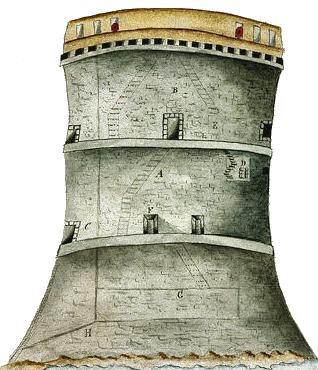Martello Towers in Europe
Outside of the UK, Martello Towers were built in Croatia, Guernsey, Ireland, Italy, Jersey, Malta and Spain in Europe.
Croatia
Built in 1813. Korčula Forteca Korčula (Fort Wellington) 1813 Deserted, accessible to hikers
Guernsey
There are three similar Martello towers in Guernsey, all built in 1804: Fort Grey, Fort Hommet and Fort Saumarez.[36]
In addition, there are a number of earlier towers in Guernsey (the Guernsey loophole towers), that many people refer to as Martello towers, though they are not Martellos. They were built in the late 18th century, i.e., before the Martellos, and differ from them in a number of ways. One may think of them as precursors,[8] like the Genoese towers they resemble.
Lastly, Bréhon Tower, built in 1856, is an oval tower that represents the final evolution of the Martello tower.[37]
Italy
At the beginning of the nineteenth century, during the British "Protectorate" of Sicily after the escape of the Bourbons from Naples, Sicily began to build towers to resist an invasion by Napoleon's armies led by Joachim Murat. The new higher rate of fire of ships' guns led to the choice of the Martello tower as the model.
The Sicilian Martello towers were built around 1810. The estimate rests on the historical context and on the descriptions of the topographer W.H. Smyth, who carried out his research in 1814 and 1815. Of the seven towers built in Sicily, only four remain. One is the Mazzone Tower (or the British Fort) at Faro Point, Messina. The second is the Magnisi tower at Priolo Gargallo, Syracuse. The Italian Navy used this tower as an observation post during the Second World War. Third is the Cariddi tower at Ganzirri in Messina. Lastly, the fourth tower is situated on a rocky outcrop overlooking the sea from where it can defend the Castello Maniace in Syracuse.
Malta
The British never built any true Martello Towers in Malta. However, Madliena Tower, which was one of thirteen De Redin towers built in Malta in 1658–1659, began to be used as if it was a Martello Tower and it is sometimes considered as such. Various modifications were made, including mounting a 64-pound rifled muzzle loading gun on the roof for coastal defence. From the late 19th century onwards it defended part of the Victoria Lines. The tower remained in use until World War II. It still stands today, despite having some minor modifications to its original structure, and it was recently restored.









 Red Dragon I.T. Ltd.
Red Dragon I.T. Ltd.